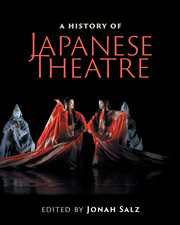Book contents
- Frontmatter
- Contents
- List of figures
- List of tables
- Contributors
- Contributors’ biographies
- Foreword
- Acknowledgments
- Note on Japanese terms
- List of abbreviations
- Timeline
- Editor's introduction
- I Traditional theatres
- Preface to Part I Japanese civilization arises
- 1 Ancient and early medieval performing arts
- Interlude Katari narrative traditions: from storytelling to theatre
- 2 Noh and Muromachi culture
- Interlude Noh and kyogen costumes and masks
- 3 Kyogen: classical comedy
- Interlude Iemoto : the family head system
- 4 Kabuki: superheroes and femmes fatales
- Interlude Nihonbuyo: classical dance
- Interlude Okinawan theatre: boundary of Japanese theatre
- 5 Bunraku: puppet theatre
- Interlude Misemono and rakugo : sideshows and storytelling
- Interlude Kamigata geinō : Kyoto-Osaka style
- Interlude Traditional theatre tomorrow: interview with Takemoto Mikio
- II Modern theatres
- Preface to Part II
- III Arcs and patterns
- IV Theatre architecture
- Preface to Part IV Evolution of Japanese theatre architecture
- V Theatre criticism
- VI Intercultural influences
- Epilogue: Frozen words and mythology
- Further reading
- Index
- References
Interlude Kamigata geinō : Kyoto-Osaka style
from Preface to Part I Japanese civilization arises
Published online by Cambridge University Press: 05 July 2016
- Frontmatter
- Contents
- List of figures
- List of tables
- Contributors
- Contributors’ biographies
- Foreword
- Acknowledgments
- Note on Japanese terms
- List of abbreviations
- Timeline
- Editor's introduction
- I Traditional theatres
- Preface to Part I Japanese civilization arises
- 1 Ancient and early medieval performing arts
- Interlude Katari narrative traditions: from storytelling to theatre
- 2 Noh and Muromachi culture
- Interlude Noh and kyogen costumes and masks
- 3 Kyogen: classical comedy
- Interlude Iemoto : the family head system
- 4 Kabuki: superheroes and femmes fatales
- Interlude Nihonbuyo: classical dance
- Interlude Okinawan theatre: boundary of Japanese theatre
- 5 Bunraku: puppet theatre
- Interlude Misemono and rakugo : sideshows and storytelling
- Interlude Kamigata geinō : Kyoto-Osaka style
- Interlude Traditional theatre tomorrow: interview with Takemoto Mikio
- II Modern theatres
- Preface to Part II
- III Arcs and patterns
- IV Theatre architecture
- Preface to Part IV Evolution of Japanese theatre architecture
- V Theatre criticism
- VI Intercultural influences
- Epilogue: Frozen words and mythology
- Further reading
- Index
- References
Summary
Kamigata (上方) refers to Kyō, or Kyoto, seat of the imperial court from 794 to 1868, and its surrounding areas. Kamigata geinō refers to the performing arts of the Kyoto-Osaka area, a millennium-old tradition displaying distinct characteristics compared to upstart Edo (Tokyo) forms. Kyoto, and then the commercial center Osaka, were cradle and constant contrast to artistic styles developed in the later capital of Edo.
Nations develop representative culture and performing arts at their political centers. In Japan's Yamato and Nara eras (300–784), the capital Nara was its center; when the capital transferred to Kyoto in 794, the cultural center also shifted. Yet even after Edo became the political center in 1603, Kyoto's centrality to culture and performing arts continued for another century. When Edo developed as a political and cultural capital, it first borrowed Kyoto culture, then gradually created its own performing arts style. After 1700, the performing arts of each of Japan's great cities – the political capital of Edo, the old capital of Kyoto, and the merchant hub of Osaka – began to develop its own distinctive characteristics.
Three competing cities
During the Edo period (1603–1868), the three cities of Kyoto, Osaka, and Edo enjoyed special status, and the discourse concerning these three cities (santo-ron), comparing their unique characteristics, was in vogue. The system to deal with the three cities as distinct entities was also employed in kabuki-hyōbanki (commentaries on kabuki) published annually, beginning in the middle of the Edo period. Even after the abolition of feudal domains with the Meiji Restoration, the three cities had their status changed to fu (regions) not ken (prefectures), as in the rest of the country, as they had never been feudal domains originally.
As Kyoto's power declined with the shogunate's transfer to Edo, Osaka's economic power grew, and “Kamigata” came to include both places as antipode to Edo. As Osaka's power increased further, Kamigata culture and performing arts became dominated by those of Osaka. However, in nihonbuyo, at least, Kyoto retains its distinct culture even today.
Even before the city of Edo was formed, numerous branches of literature, fine arts, and performing arts developed and flourished in Kyoto. Music and dance genres introduced from abroad such as gagaku and bugaku, appropriated to forge a national culture, had by the eleventh century already become distinctively Japanese performing arts.
- Type
- Chapter
- Information
- A History of Japanese Theatre , pp. 190 - 191Publisher: Cambridge University PressPrint publication year: 2016



